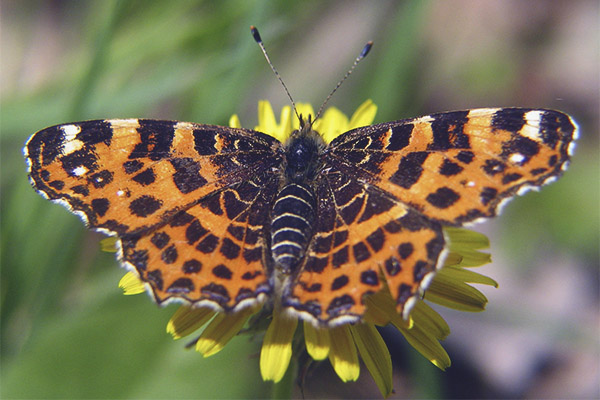The content of the article
It was not in vain that the piedplate of changeable gave this name. And her behavior has nothing to do with it. Everything is much easier. This butterfly is a bright representative of seasonal dimorphism; it was thanks to him that the scientists gave this name. This species can form an infinite number of forms of local importance, but at the same time, the constancy of the two main remains unchanged.
Description
The average size of the wings is up to 4 cm. The front wing of this insect is from 15 to 22 mm.
In nature, they exist in special forms:
- Spring generation. Differs not such large size and color of the wings. From above, they have yellow-orange or red hues, with black spots against them. Below on an orange background is a white pattern, very reminiscent of a mesh; It is necessary to fold the wings, and it is almost invisible.
- Summer Individuals are larger. The difference in color is very contrast. It is dark, almost black, and only yellow and orange specks remain,as well as white or pale yellow stripes.
A third generation may also be formed, which is very similar to the generation of the spring period. This is expressed in color. The wings retain a dark pattern.
The summer pollen is very unusual in that it only, having two main forms, managed to form many local ones. But man also liked to experiment due to the fact that if you create different thermal regimes for the pupae, it is possible to observe interesting thermal forms.
Lead a day life, as the night air is too cold for them.
Habitat
This taiga northern places and especially dry steppe zones do not attract this butterfly. Because in some places in Russia and Ukraine it is not. Only at the mouth of the Dnieper, in the districts of the Kherson region, can this species be seen occasionally, but in the mountainous regions of the Caucasus and the Carpathians there are a lot of them.
The pisilli settles in places rich in meadow zones or along river banks. In the forests of various types chooses the edge. It is based on vacant lots, beams, covered with shrubs and along the roadsides, it feels comfortable in the gardens. If a butterfly of this species lives in a mountainous area, it does not rise above 1,400 m above sea level. The main thing is to be wet and closed from the sun.
Biological data
The development of the pest buglet takes place by two generations. Dates of summer vary:
- the first decade begins in April and ends in June;
- the second lasts from July to August.
Lay in the form of eggs. They are stored on the lower surface of the leaves, glued to each other. Moreover, this forms a kind of chain, which contains from 5 to 15 eggs. You can recognize them by oval and greenish color. When the first chain appeared, the female tirelessly forms a new one. So one sheet withstands more than 100 eggs. After 6 days, the offspring will appear. Here is such an unusual hospital on a small sheet.
Caterpillars of the first generation are gradually developing and gaining strength. This period lasts from May to September. They have a black-brown color.They find a fodder plant, and everyone starts to eat it together. Typically, the caterpillars live in a whole colony, not crawling away from each other until the fourth molt occurs. Then it is time for them to live alone. The caterpillar development period lasts for four weeks.
Before they turn into a pupa, they again find a fodder plant or other reliable shelter. The pupa should attach itself to the top of the abdomen. Then hangs upside down and waits in the wings.
The offspring of the second generation is characterized in that pupae hibernate. Therefore, they can be seen so early: in the spring, you can already see a fluttering lovely pachyrokrylnitsu, which has a typical form. But it may happen that from the first generation the pupae also wait out the cold season and also appear in the spring butterflies with the same typical form.
Caterpillars often feed on plants that belong to the fodder group, and also prefer nettle or stinging nettles. Butterflies collect the nectar of various herbaceous or shrubby plants, and they feed on them.
Males jealously guard their territory.If he settled in a clearing, he constantly flies around her, and if another male has appeared, he can join the fight with him, and then he sits down to rest on the protruding plant, in order to start patrolling again.












To send